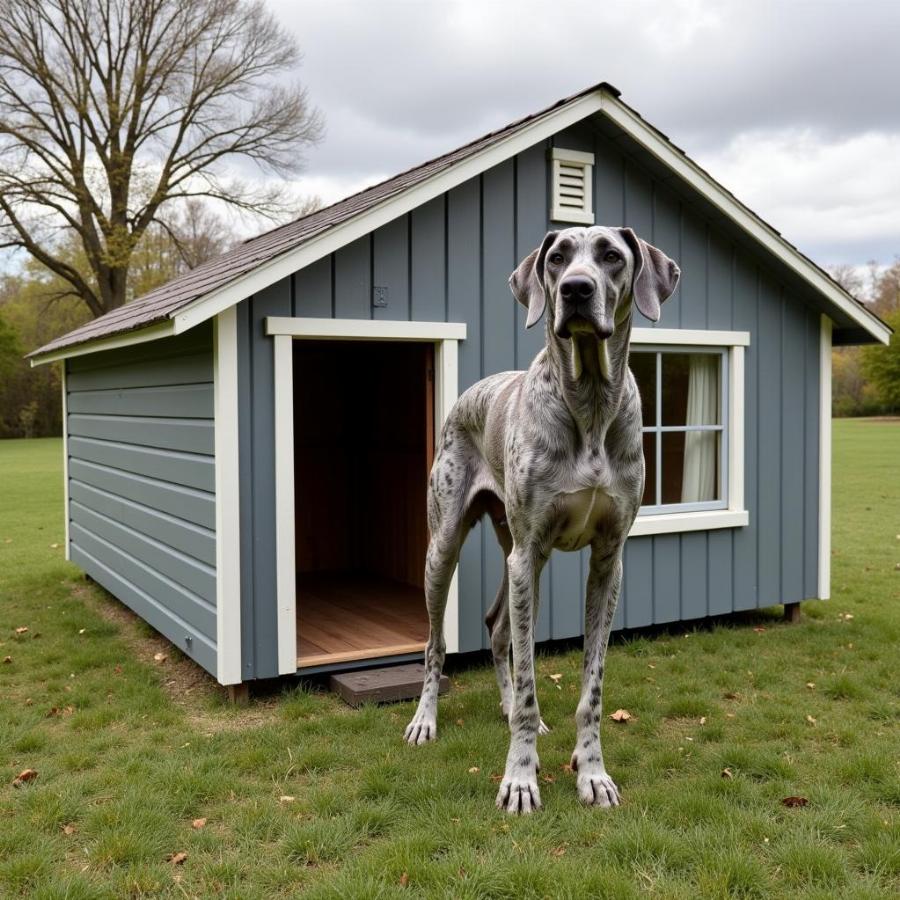When it comes to our canine companions, their comfort is paramount. For those blessed with extra-large dog breeds, finding suitable shelter can be a challenge. That’s where extra large insulated dog houses come into play, providing a haven where your furry friend can relax and weather any storm. In this article, we will explore everything you need to know about extra large insulated dog houses, from choosing the right size and features to ensuring your dog’s comfort and safety.
Finding the Perfect Fit: Size Matters
Just like humans, dogs appreciate a bit of personal space, especially giant breeds. An undersized dog house defeats the purpose of providing comfort and insulation. A good rule of thumb is to measure your dog’s height (while standing) and length (from nose to tail base). The ideal dog house should be at least 1.5 times your dog’s height and long enough for them to lie down comfortably with room to spare.
 Choosing the Right Size for Your Dog
Choosing the Right Size for Your Dog
Battling the Elements: Insulation is Key
Extra large dog breeds often have shorter coats compared to their smaller counterparts, making them more susceptible to extreme temperatures. Insulation plays a crucial role in regulating temperature inside the dog house, keeping your furry friend warm in winter and cool in summer. Look for dog houses with double-wall construction and insulation materials like foam, straw, or reflective foil.
Beyond the Basics: Features to Consider
When browsing through extra large insulated dog houses for sale, consider these features:
-
Elevated Floor: An elevated floor provides insulation from the ground, keeping the house warmer in winter and cooler in summer.
-
Adjustable Vents: Vents allow for air circulation, crucial for preventing overheating in summer and moisture buildup in winter.
-
Removable Roof: A removable roof simplifies cleaning and provides easy access to your dog in case of emergencies.
-
Durable Materials: Choose a dog house built with weather-resistant materials like treated wood or high-quality plastic to withstand the elements.
Location, Location, Location: Placement is Key
Even the best-insulated dog house won’t perform optimally if placed incorrectly. Consider these factors when deciding on a location:
-
Shade: Direct sunlight can lead to overheating, especially in warmer months. Place the dog house in a shaded area or provide additional shade with trees or tarps.
-
Drainage: Ensure the chosen spot allows for proper drainage to prevent water from pooling around the dog house during rainy seasons.
-
Wind Protection: Position the dog house with its back to prevailing winds to minimize drafts and maximize insulation.
-
Visibility: Choose a spot where your dog can easily see the house and yard, allowing them to feel secure and connected to their surroundings.
Creating a Cozy Haven: Bedding and Accessories
Choosing the right bedding is crucial for maximizing comfort and insulation. Avoid using old blankets or towels as they tend to retain moisture. Instead, opt for:
-
Cedar Shavings: Natural insect repellent and provide excellent insulation.
-
Straw: Affordable and effective insulation, especially during colder months.
-
Elevated Dog Beds: Provide additional insulation from the floor and promote air circulation.
You can also enhance your dog’s comfort with accessories like:
-
Heated Pads: Provide warmth during frigid winters.
-
Cooling Mats: Help regulate body temperature during hot summers.
-
Dog House Curtains: Offer additional insulation and privacy.
Ensuring Safety and Happiness
While a dog house provides shelter, it should never be a substitute for proper care and attention. Always supervise your dog while they’re outside and ensure they have access to fresh water and shade.
Frequently Asked Questions
How do I know if my dog house is well-insulated?
A well-insulated dog house will feel noticeably warmer inside than the outside temperature during winter. In summer, it should remain relatively cool. You can also check the temperature inside the house with a thermometer to ensure it’s within a comfortable range for your dog.
Can I use a regular dog house for an extra-large breed?
It’s not recommended. Regular dog houses are not designed to accommodate the size and insulation needs of extra-large breeds. An undersized or poorly insulated house can negatively impact your dog’s health and comfort.
How often should I clean my dog’s insulated house?
Regular cleaning is essential for maintaining hygiene and preventing odor. Aim to clean the dog house at least once a month, or more frequently if needed. Remove bedding, dispose of waste, and scrub the interior with pet-safe disinfectant.
Looking for More Dog Care Tips?
Check out these related articles:
About Beaut Dogs
Beaut Dogs is your trusted source for all things dog-related! We provide expert advice, tips, and resources to help you care for your canine companion. For personalized guidance on choosing the perfect extra large insulated dog house, feel free to contact us at [email protected]. We’re here to help!